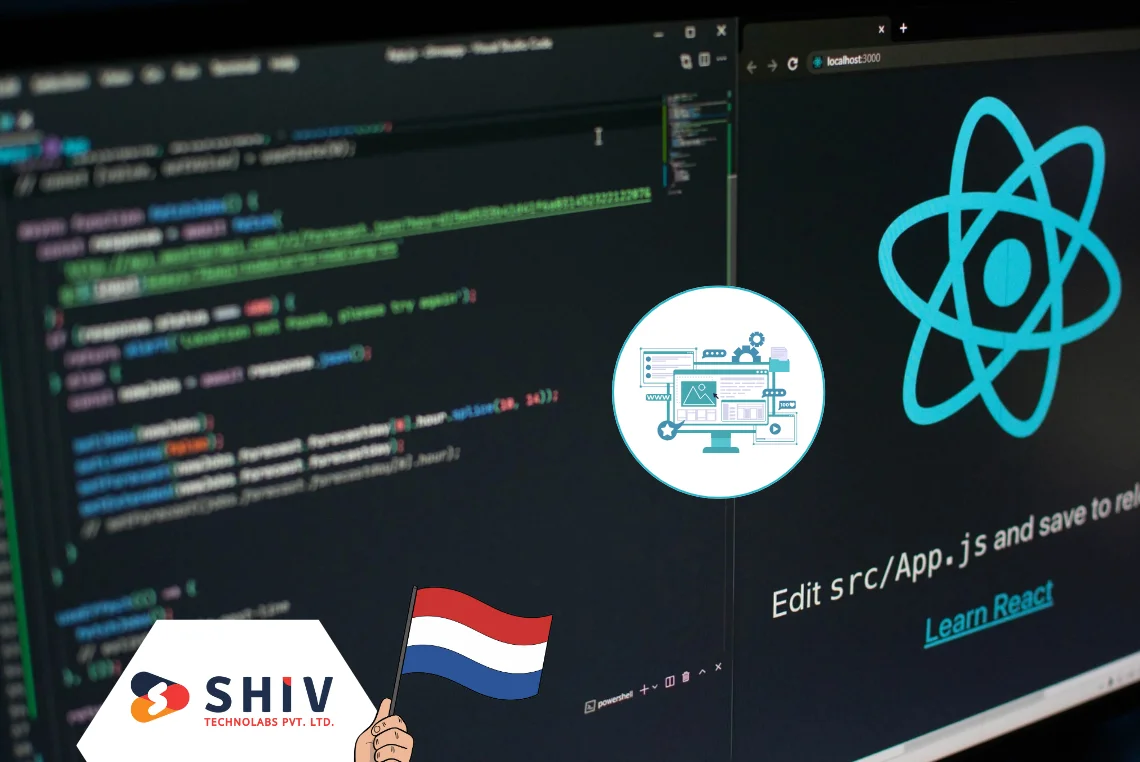Table of Contents
Web development changes quickly, and Next.js Web Development Services help product teams ship fast, interactive websites with less friction. The framework blends React with production-ready patterns that shorten setup, cut risk, and support steady releases. In this blog, we outline current capabilities, real adoption at scale, and what arrives next for teams.
Next.js reduces overhead through smart routing, modern rendering, and helpful defaults that match complex delivery roadmaps. Companies see higher reliability across features, while developers ship confidently with a clear, measurable feedback loop. You get faster delivery, stronger performance, and a stack that adapts as needs change over time.
What Is Next.js?

Next.js is a React framework for building fast sites and apps using flexible rendering choices in one codebase. Teams can ship pages as static output, render on the server at request time, or mix both models when it fits. Helpful defaults such as fast refresh, automatic code splitting, and file-based routing keep projects tidy and easier to scale.
The framework offers clear patterns for data fetching, image handling, and routing that map well to real features. Developers stay productive because the tools remove boilerplate, reduce configuration churn, and guide better structure. Businesses benefit from predictable delivery, stronger reliability, and a stack that supports steady product growth.
Clear documentation and friendly APIs help teams get value without long setup cycles or fragile glue code. Small sites launch quickly, while larger platforms keep their momentum across multiple squads. This balance makes Next.js a practical default for many web products.
The Future of Next.js: A Glimpse into Web Development’s Evolving Landscape

Next.js continues to grow with edge rendering, serverless patterns, and headless content systems used across teams. The roadmap emphasizes faster builds, simpler data flows, and better tooling that reduce maintenance overhead. These changes help companies release more often while keeping performance steady under real traffic.
The framework also focuses on developer clarity, which lowers onboarding time across squads and vendors. Stronger defaults replace brittle custom setups that slow delivery and create regressions. As the ecosystem matures, teams gain confidence to plan larger initiatives without pausing momentum.
# Enhanced Developer Experience
Next.js keeps trimming boilerplate with simpler APIs, clearer errors, and faster feedback while you code. Smart routing, fast refresh, and automatic chunking remove repetitive tasks that slow daily work. Teams collaborate better as TypeScript support tightens and error messages guide quick fixes.
Stronger dev-tools help engineers trace data flow, check bundle impact, and reduce regressions early. The project structure stays predictable across features, which improves handoffs between squads. That consistency helps companies scale teams without slowing releases or risking quality.
# Serverless Functions
Serverless functions in Next.js let teams add backend logic without running or patching servers. Engineers keep API code near the UI, which shortens feedback loops and simplifies reviews. This pattern scales during traffic spikes and supports tasks such as auth, webhooks, and scheduled jobs.
Vendors handle capacity and availability, while your code focuses on product behavior. Logs and metrics remain accessible for debugging, and versioning keeps rollbacks clean. The outcome is faster delivery, less operational burden, and features that adapt to changing demand.
# Server-Side Rendering (SSR)
SSR renders pages at request time, which helps first paint, data freshness, and search visibility. Large catalogs, dashboards, and personalized flows benefit from strong HTML on arrival. Teams pair SSR with caching and streaming to keep responses quick under load.
As projects scale, consistent SSR patterns reduce complexity across services and regions. Monitoring tracks render speed and errors so squads can fix bottlenecks early. This approach supports demanding use cases without sacrificing delivery pace.
# Static Site Generation (SSG)
SSG prebuilds pages during compile, delivering instant responses with very low runtime cost. It fits blogs, docs, landing pages, and catalog entries that change less often. Teams often combine SSG for stable routes and SSR for data-heavy screens in one repo.
Incremental approaches help rebuild only pages that changed, which keeps build times predictable. Content teams push updates quickly without touching core app logic. Users get fast loads and consistent behavior across devices and regions.
# Headless CMS Integration
Next.js Analytics highlights real performance, user flows, and stability issues across routes. Teams find slow paths early, then fix code or assets before revenue suffers. Dashboards and tracing support decisions that lift reliability over multiple releases.
As visibility improves, squads can compare changes, track regressions, and share insights with stakeholders. Better signals lead to cleaner rollouts and fewer emergency patches. Users feel the difference through faster interactions and steady behavior.
# Enhanced Analytics and Data Insights
Clear docs, sane defaults, and strong examples lower the barrier for newcomers and busy teams. Companies adopt proven patterns that work well across people and projects. That consistency supports training, hiring, and vendor collaboration without fragile custom stacks.
Pre-built utilities and templates help squads ship features quickly with fewer unknowns. Shared practices make code reviews faster and reduce regressions. The end result is steady delivery and a codebase that remains easy to extend.
# Democratization of Web Development
One of the broader goals of Next.js is to democratize web development, making it accessible to both experienced developers and newcomers. The framework’s focus on comprehensive documentation and an intuitive development experience ensures that developers at all levels can create powerful applications without being bogged down by complexity.
The future of Next.js points toward simplifying workflows even further by offering pre-built components, easier API integrations, and more comprehensive development tools, ensuring that web development is approachable and scalable.
# Sustainability and Accessibility
Static output, smart caching, and smaller bundles reduce compute use and bandwidth waste at scale. Teams deliver quicker pages that feel responsive on varied networks and devices. These patterns support greener operations without sacrificing product goals.
Next.js patterns align with accessible structure, keyboard paths, and readable content. Libraries and checks help teams catch issues before launch and during updates. Inclusive design reaches more people while meeting legal and brand requirements.
# Built-in API Routes
API routes live beside pages, which keeps frontend and backend changes aligned. Engineers ship features faster because endpoints travel with the UI they support. Reviews and rollbacks stay simpler when everything sits in one repository.
Expect richer middleware, auth helpers, and background tasks that expand these workflows. Teams gain consistent patterns for headers, caching, and security checks. This cohesion reduces maintenance work while improving developer focus.
# Seamless API Integration
Next.js connects to outside services through built-in routes or server data-fetching inside components. Secrets remain on the server, and responses arrive as ready-to-render props or streamed content. Teams reduce client-side churn and keep bundles lean for quicker interaction.
As patterns mature, integrations require less glue code and fewer one-off adapters. Shared utilities handle retries, timeouts, and schema validation across services. That consistency helps squads deliver new features without risky rewrites.
# SEO and Performance
Next.js supports strong Core Web Vitals through smart rendering, code splitting, and modern image handling. Search engines receive HTML on first load, which helps discovery and ranking. Prefetching, caching, and lean bundles keep interactions quick after the initial paint.
Monitoring highlights slow routes and assets so teams can fix issues early. Clean URLs, structured markup, and predictable routing help crawlers map the site. These practices lift visibility while keeping the experience fast for real users.
Final Remarks
Next.js gives teams a practical path to speed, reliability, and steady delivery. The ecosystem pushes forward on builds, analytics, and data flows that help real products win. Whether you run content sites, storefronts, or dashboards, the framework supports ambitious roadmaps.
Adopting clear patterns reduces risk across features and regions as teams expand. Strong defaults replace brittle stacks that block launches and slow fixes. With Next.js, companies move faster while keeping quality high and costs under control.
At Shiv Technolabs, we design and build Next.js applications that match your growth goals and brand standards. Our team plans sound architectures, sets up CI/CD, and delivers clean components that fit your design system. We also audit existing builds, fix bottlenecks, and shape roadmaps that keep releases steady.
Looking for a clear plan and predictable delivery? Hire Next.js developers and start with a scoped discovery, milestones, and measurable outcomes. We align with your stakeholders, reduce rework, and launch features that move real metrics across markets.




















